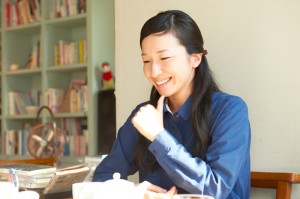Discover Noppe and Salted Salmon: Traditional Japanese New Year Delicacies
Dec 12,2014
Discover Noppe and Salted Salmon: Traditional Japanese New Year Delicacies
Dec 12,2014
In this irregular series, food culture researcher Kiyoshi Aya describes the local delicacies and ways of life she has encountered in different places throughout Japan.

For this article, Kiyoshi tells us about New Year’s dishes from Niigata city in Niigata prefecture. She first describes one essential New Year’s dish in the area — noppe soup.
“Noppe is a homegrown Niigata soup that people in the area eat all the time. Lots of different ingredients are put in noppe, including taro, carrots, konjac, tube-shaped fish paste, boiled fish paste, and ginkgo nuts. The ingredients are lightly simmered in a broth of dried shiitake mushrooms and dried kaibashira [adductor muscle taken from shellfish]. For New Year’s, kuwai root, lotus root, and other vegetables that are considered good luck are added to the noppe.
“Most people eat noppe chilled in summer and hot in winter. But on my visit to Niigata, I met a woman who said ‘Eating cold noppe in a warm room during the cold season is a joy.’ That brought a smile to my face.”

“Noppe is a homegrown Niigata soup that people in the area eat all the time. Lots of different ingredients are put in noppe, including taro, carrots, konjac, tube-shaped fish paste, boiled fish paste, and ginkgo nuts. The ingredients are lightly simmered in a broth of dried shiitake mushrooms and dried kaibashira [adductor muscle taken from shellfish]. For New Year’s, kuwai root, lotus root, and other vegetables that are considered good luck are added to the noppe.
On Sado Island, a short distance out in the sea, things are a little different. “Sado is part of Niigata prefecture, but the island has long had close ties with western Japan via sea routes. People on Sado make nishime [a vegetable dish simmered in soy sauce until the liquid is almost gone] instead of noppe for New Year’s. The broth is made from dried flying fish and dried barracuda, to which diced daikon radish, carrots, grilled tofu, konjac, and other ingredients are added. After adding fish or squid, the nishime is boiled down resulting in more of a sweet soy sauce flavor, compared to the lighter flavor of Niigata city’s noppe. It’s interesting that different food cultures have sprung up in the same prefecture.”

“Another essential part of New Year’s in Niigata are dishes made with salmon, the region’s toshitorizakana,” Kiyoshi adds, using a word unfamiliar to me. Toshitorizakana refers to a fish offered on a household’s kamidana altar on New Year’s eve and then eaten to celebrate the New Year. The type of fish used for toshitorizakana varies from region to region, but generally speaking, yellowtail is eaten in many regions in western Japan while salmon is eaten in many parts of eastern Japan.
During the Edo period (1603 to 1868), wild salmon successfully propagated in the Miomotegawa river, which flows through Murakami, Niigata, and a unique culture developed in the area around salmon. Salmon that has been rubbed with salt and then dried, called shiobiki sake, is still a specialty in Murakami. Many in Niigata like to give shiobiki sake as a year-end gift. “People in Niigata tend to have their preferred type of shiobiki sake, and as the end of the year draws near, they go out of their way to place orders for fatty or extra salty shiobiki sake from their neighborhood fishmonger.”
The region’s climate is the trick to shiobiki sake’s delicious flavor. The drying process is slowed by the low temperatures and strong winds, which lets the natural umami mature further and develop into a deep, rich flavor.


“Salmon are used in many different New Year’s dishes. One example is hizunamasu, a New Year’s staple. Hizunamasu is made by cutting the cartilage of a salmon’s head, called hizu, into thin slices and softening them in vinegar, to which grated daikon radish, cucumber, and salmon roe are added.”
Kiyoshi adds: “The locals even use salmon in o-zoni [rice cake soup].” Zoni made with mochi rice cake, salmon, burdock root, deep-fried tofu, fish paste, and salmon roe sounds simply sumptuous with all its ingredients. Some regions and families cook the salmon roe in with the soup, while others serve the soup garnished with raw salmon roe on top.
Kelp rolls are another dish that showcases different types of fish depending on the region. In Niigata, they naturally use salmon. “Wrapping the salmon in kelp and simmering it lightly in a broth made from the bony parts of the fish results in kelp rolls with beautiful colors and a Niigata taste that takes full advantage of the salmon’s deliciousness.”
Izushi sushi is another richly flavored dish made with fermented salmon. Locals are very familiar with this dish, in which the salmon, hizu, herring roe, rice, and rice malt are combined to produce lactic fermentation.
“We tend to talk about osechi-ryori [New Year’s food] as if it’s one thing. But there are enormous regional variations in what foods are made and what ingredients are used. We can catch a glimpse of a region’s history and culture during New Year’s, when we can enjoy the best of the best of local ingredients. My wish is that these traditional food cultures are passed on, by, for example, giving children opportunities to experience them on festive days.”


food culture researcher
food culture researcher
food culture researcher and Secretary of the Research Division at the National Council for Washoku Culture
Born in Osaka prefecture, Kiyoshi is involved in researching traditional regional Japanese cuisine and the dietary habits in fishing and farming communities as well as writing and giving lectures about local foods.
Recent publications include Washoku Techo [Washoku Handbook] (co-author, published by Shibunkaku), Furusato no Tabemono [Hometown Food] (Washoku Culture Booklet No. 8) (co-author, published by Shibunkaku), and Shoku no Chizu [Maps of Food], Third Edition (published by Teikoku-Shoin).